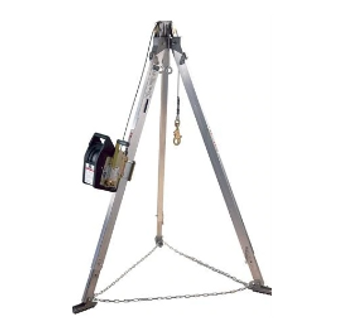Pieces of the Confined Space Entry Puzzle
Nearly every type of industrial site has confined spaces - manholes with plumbing, or sheds that house pumps or generators. These are areas where the atmosphere may become toxic or oxygen-depleted and unsafe for entry. If you or your crew don't do much work in these areas you may not be aware of the dangers or the regulations surrounding them.
Here are a few things that you will need if you are preparing to enter a confined space. They are all important, most of them are required by law, and we'll show you why.
The four-gas monitor measures levels of Oxygen (O2), Hydrogen Sulphide (H2S), Carbon Monoxide (CO) and Lower Explosive Levels (LELs) of things like Methane. The need for this should be pretty self-explanatory - and it is required by OSHA that you check the atmosphere before you enter a confined space.
Remember if you are entering a tank, all levels must be checked (top, middle, bottom) as different gases will gravitate to different areas of a space. Once you have entered the space, a diffusion monitor, or a pump monitor working in diffusion mode, will alert you to any changed in the atmosphere. If it goes into alert mode, it's time to get out.
One of the first rules of confined space entry is "If you go in, know how you are going to get out". If you are entering a manhole, tank, or silo - the kind of place without an overhead attachment point for a retrieval device, you are going to have to create one. In many circumstances this can be done by erecting a collapsable tripod over the entrance area. Horizontal entrance hatches, or tank entry may pose specific challenges for retrieval and more specialized equipment may be required.
Your average worker is going to be well over 160 lbs. Most likely over 180 or more with tools and clothing. That's why a winch is required. The ability to pull an incapacitated worker out of a space without more people entering is critical in confined space rescue. Winches come with different lengths of steel cable and give you the mechanical advantage to pull up to 310 lbs. of inert weight. If you are working with a tripod, the winch often attaches to one of the legs, and the lifeline is run through.
If you have any questions, give PK Safety a call. Our staff is not paid on commission, so our only goal is to help you get the safety equipment that best suits your situation. Thanks for reading.
Recent Posts
-
Promoting Safety: National Work Zone Awareness Week is April 15-19, 2024
Each year, the National Work Zone Awareness Week (NWZAW) places the spotlight on the importance o …Apr 11th 2024 -
Understanding 4 Gas Monitors: How They Work & Why They Are Important
In today’s increasingly dynamic industrial landscape, 4 gas monitors have emerged as critical com …Apr 8th 2024 -
April Showers Require Workers to Wear Hi-Vis Safety Rain Gear
While April showers bring May flowers, they also bring challenges, particularly for those working …Apr 1st 2024





